Buddha and the Cosmos
Day 1
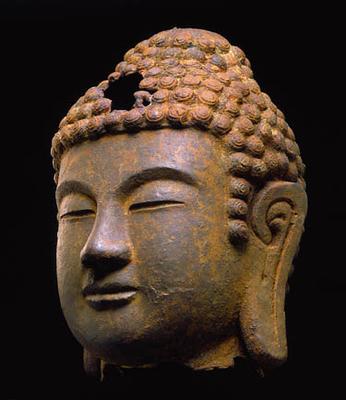
Head of Buddha, Korea, Unified Silla Dynasty,
late 8th/early 9th century. Cast iron. Detroit Art Institute, 1988
Buddhism was introduced into Korea from China during the late 4th century (the traditional date, 372 AD). It did not, however, enter the Kingdom of Silla, whose capital was Gyeongju, until the 5th century. At the height of its efflorescence and power Gyeongju was the equal of Chang-an, the capital of the Tang dynasty. Initially accepted during the reign of King Jinheung (540-576), Mahayana Buddhism soon spread throughout the realm of Silla. During the late period, so-called Unified Silla, thousands of temples were built to the Buddha, tens of thousands of stone and bronze representations of him.
This heroic head differs in being made of iron. It has been detached from the body of a heroic statue. Its narrowed eyes and schematic crescent-shaped eyebrows present an ambiguous image both of deep inward meditation and outward exercise of power. Chinese and Northeast Asian Buddhist images, unlike their passive Hinayana (Theravada) counterparts, in Southeast Asia, are active, and though the meditative Chan sect (brought to Korea by Beomang in the 7th century) leads to Seon Buddhism, in Korea, and Zen, in Japan, these sects do not conform to the modern or western stereotype of quietude.
Inflationary cosmology modifies the big bang theory by inserting an intense burst of fast expansion during the universe’s earliest moments. This modification proves essential to explaining otherwise perplexing features of the relic radiation. But more than that, inflationary cosmology is a key chapter in our story, because scientists have gradually realized over the last few decades that the most convincing versions of the theory yield a collection of parallel universes, radically transforming the complexion of reality.
Chinese influence in the depiction of the Buddha is here seen in the round face, the slits for eyes, the large-lobed ears (indicative of nobility and wealth), the tight curls of hair that to the Chinese eye resemble the surface of a fruit called the shi-zi tou (or lion’s head). Rather than a merely meditative quietude, the massive form and stately expression of the head here exude confidence, as in the historical replacement of Gyo (learning or study) with self-determined spiritual authority. Upon their return from China, Korean monks founded nine “mountain schools” to promulgate their new doctrines.
Thus asceticism and monasticism reinforced meditative practice, and a removal from urban centers into Nature purified it. The ultimate source of the image above is the original expression in India of Gupta styles, transmitted through the medium of Tang art. The Tang, unlike other periods of Chinese art, had been open to foreign influence, and was strengthened by it. The Tang influence was felt everywhere in Korea, in learning and cultural development. This great dynasty eventually allied itself politically with the Silla dynasty, and the two retained strong cultural ties, after the Silla had become independent.
Day 2
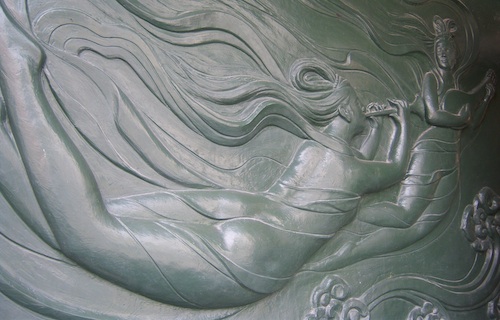
Cosmology is the one field in which we can actually witness history. The pinpoints of starlight that we see with the naked eye are photons that have been traveling toward us for thousands of years. The light from more distant objects, captured by telescopes, has been traveling for billions of years. When you see such ancient light, you are looking at ancient times. Those primeval comings and goings transpired far away, but the large-scale uniformity of the universe argues that what was happening there was also happening here.
Mahayana conceives of Buddha as Universal, with an infinity of forms. It worships the cosmic Buddha, the dharmakaya; the historical Buddha, sambhogakaya, and the transformation Buddha, nirmanakaya. Buddha Sakyamuni, the actual Buddha, is the Korean’s principal spiritual guide, whose teachings, they believe, can end human suffering in this world and lead toward the highest spirituality, namely nirvana. Vairocana Buddha is the Cosmic Buddha who spreads the light of his truth in every direction. Amithabha Buddha is the Buddha of infinite light and governs the Pure Land, the Western Paradise.
In an Inflationary Multiverse the member universes are divided. Each is a hole in the cosmic cheese, separated from the others by domains in which the inflaton’s value remains high. Since intervening regions are still undergoing inflationary expansion, the bubble universes are rapidly driven apart, with a speed of recession proportional to the amount of swelling in space between them. The farther apart they are, the greater the expansion’s speed; the ultimate result is that distant bubbles move apart faster than the speed of light.
Avalokitesvara (Guanseum Bosal in Korean) is the Bodhisattva of Compassion. Her name means “Hearer of Cries.” She is frequently pictured with a vase and a willow spray. The vase contains amrita, the nectar of compassion, or the waters of life. The willow branch represents her ability and willingness liberally to sprinkle “sweet dew” on the afflicted. Ksitigarbha (Jijang Bosal in Korean) is the Bodhisattva of relieving the suffering of the nether world. He is usually bald, or has closely cropped hair, and he holds in one hand a staff or a sistrum, and in the other hand, a jewel, the “wish-fulfilling” gem.
Although string theory has an intimidating reputation, its basic idea is easy to grasp. We have seen that the standard view, prior to string theory, envisions nature’s fundamental ingredients as point particles — dots with no internal structure — governed by the equations of quantum field theory. With each distinct species of particle is associated a distinct species of field. String theory challenges this picture by suggesting that the particles are not dots. Instead, the theory proposes that they are tiny, string-like, vibrating filaments.
Day 3

An exciting feature of string theory is that the particles emerge from the theory itself: a distinct species of particle arises from each string vibrational pattern. And since the pattern determines the properties of the particle, if you understand the theory, you will be able to explain all properties of all particles. The potential and the promise, then, is that string theory will transcend quantum field theory by deriving all particle properties mathematically. Gravitons imply that the theory also provides a quantum theory of gravity.
The 2,500 year history of Korean Buddhism has given rise to many large temples. Among them the Three Jewel Temples are the most famous and largest in Korea. The three jewels of Buddhism are Buddha, Dharma and Sangha. The Three Jewel Temples represent each aspect: Tongdosa Temple represents the Buddha, because it has a famous stupa (or pagoda) housing relics from China; Haeinsa Temple represents the teaching or Dharma, because it contains Buddhist scriptures; and Songgwangsa Temple represents the Buddhist community, because its fifteen patriarchs stand for the Sangha.
In most situations quantum mechanics and gravity happily ignore each other, the former applying to small things like molecules and atoms and the latter, to big things like stars and galaxies. But the two theories are forced to shed their isolation in the realms known as singularities. A singularity is a physical setting, real or hypothetical, which is so extreme that quantum mechanics and general relativity go haywire, generating results akin to the error message on a calculator, when you divide any number by zero.
Tongdosa Temple was built in 646 by Master Jajang during the reign of Queen Seondeok. One of the great monks in Korean Buddhism, Master Jajang, carried Buddha’s relics from China and enshrined them in Tongdosa Temple. As a result, unlike other temples, there is no statue of the Buddha in the Main Hall. Instead, Buddhists worship the Stupa. The Diamond Precepts platform is behind the Main Hall. On the platform is a bell-shaped stupa surrounded by a stone barrier. The gate is finely decorated with dragons, clouds and two protector guardians, the ball-shaped stupa with lotus blossoms and petals.
A mathematical model provided the first quantum mechanical accounting of a black hole’s disorder. The advances in dealing with singularities and black hole entropy give the physicist confidence that the challenges of black holes and big bang will be conquered.
Haeinsa Temple is the second representative temple. Its name means “reflection on a smooth sea.” Its iconography depends upon the deep meditation of the Avatamsaka Sutra. Originally, Haeinsa Temple was a small hermitage built by Master Sunung and Master Ichong at the time of their return from China in 802. The wife of King Aejang was sick, and the two monks had helped to cure her. The King built Haeinsa Temple in honor of the monks. The temple has since been enlarged. Behind the Main Hall are two buildings that were constructed in 1488 to house the wooden blocks of the Tripitaka Koreana.
In string theory, the basic ingredient is not a point but a string, requiring a new kind of geometry, based not on points but rather on loops. The new geometry is called stringy geometry. To get a feel for it, picture a string moving through a geometrical space.
Songgwangsa Temple means “Spreading Pine Temple,” and it was established on Mt. Jogye by Master Jinul (1158-1190). In 1190 Jinul created a “Concentration and Wisdom Community” for practicing Buddhism together. Searching for the ideal location, he carved a crane out of wood, which he then released. The crane flew away and finally landed in the place where Songgwangsa Temple is today. Jinul believed that enlightenment could be quite easily reached, but that practice must continue afterwards in order to get rid of the habit energies. This is called Sudden Awakening and Gradual Cultivation.
The numbers of five-wrapped spheres packed into the Calabi-Yau proved to be harbingers for a spectrum of mathematical discoveries. Whether or not string theory offers a description of the universe, it has already established itself as a new mathematical tool.
Day 4
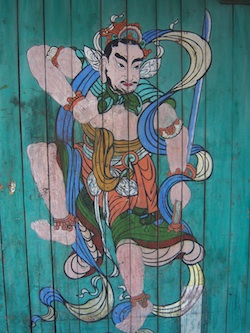
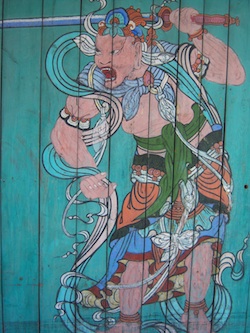
Like gravity, which contemporary physics tells us may be either positive or negative, attractive or repulsive, so the dvarapalas who guard the gates to the Buddhist temple. If the gates are closed, they repel the invader; if the gates are opened, the doors facing one another, they attract by complementing one another’s force. So in Northeast Asia, with China and Korea, Korea and Japan. China is the generator of new motifs attractive to the Korean artist, who subsequently, in his search for a self-identity, finds them repellant. Likewise with Japan, which at first receives, then rejects the influence of Korean Buddhism.
We imagine that strings are ultra-small, a feature that makes testing string theory a challenge. Strings are not, however, necessarily minute. Rather, a string’s length is controlled by its energy. The energies associated with the masses of electrons, quarks and other known particles are so tiny that the corresponding string would indeed be miniscule. But if we were to inject enough energy into a string, we could cause it to stretch large. At present we do not have anywhere near the capacity to do this here on earth, but that is a limitation of our current technological development. If string theory is correct, a civilization more advanced than ours could pump strings up to whatever size it liked. Natural cosmological phenomena also have the capacity to produce long strings; for example, strings can wrap around a portion of space and get caught up in the cosmological expansion, stretching out infinitely in the process. One of the possible experimental signatures that I have outlined looks for gravitational waves that such long strings may emit as they vibrate far away in space.
In their Handbook of Korean Art: Buddhist Sculpture, Youngsook Pak and Roderick Whitfield detail the Japanese borrowings from Korea. “The influence of Korean Buddhist sculpture on Japanese Buddhist images of the Asuka and Hakuko periods is well documented. It is recorded in the Nihon Shoki that in 552 the King of Paekche sent to Emperor Kinmei a bronze statue of Buddha, canopies, banners and copies of Buddhist sutras, recommending that the teachings embodied in these works be studied and taken to heart. Despite Japanese opposition at court, by military clans, such contacts continued to occur.”
Like strings, higher-dimensional branes can be big. And this opens up a wholly new way in which string theory can describe the cosmos. To grasp what I mean, picture first a long string, as long as an overhead electric cable that runs as far as the eye can see. Next, picture a large two-brane, like an enormous tablecloth or a gargantuan flag, whose surface extends indefinitely. These are both easy to visualize, because we can picture them located within the three dimensions of our common everyday experience.
“In 557 the King of Paekche sent a group of monks, nuns and skilled craftsmen to Japan, and in 584 Emperor Bidatsu received further Buddhist images from Korea. In 587 following Soga no Umako’s victory over conservative opponents, the Hoko-ji was built with monks of Koguryo and Paekche in charge: the Buddha Hall completed in 592 and relics placed in the pagoda foundation the following year. In 596 the Asukadera was completed, again under the supervision of Korean craftsmen from Paekche. The plans of such early Japanese temples place the pagoda inside the temple and in front of the image hall.”
If a three-brane is enormous, perhaps infinitely big, the situation changes. A three-brane of this sort would fill the space that we occupy, like water filling a huge fish tank. Such ubiquity suggests that rather than think of the three-brane as an object that happens to be situated within our three spatial dimensions, we should envision it as the very substrate of space itself. Just as fish inhabit the water, we would inhabit a space-filling three-brane. Space, at least the space that we directly inhabit, would be far more corporeal than is generally imagined. Space would be a thing, an object, an entity — a three-brane. As we run and walk, as we live and breathe, we move in and through a three-brane. String theorists call this the braneworld scenario. It is here that parallel universes have their string entrance.
“This was known as the ‘Kudara’ style, Kudara being the Japanese name for Paekche. In 588 it is recorded that Buddhist relics, monks and craftsmen skilled in bronze-casting, painting and tile-making, were sent to Japan from Korea. Thus the sculptors who worked at the Japanese court were often Korean immigrants or their descendents. Many of the Shijuhattai Butsu or Forty-eight Buddhas, among the earliest treasures given to the Horyu-ji in Nara, and now housed in The Tokyo National Museum, are thought to have been made by, under the direct influence of, Korean Three Kingdoms artists.”
Day 5

Coffee brings to every person the feeling of luxury and nobility.
It is the common man’s gold
(café window at “Coffee House / Drip & Espresso,” Gyeongju)
Tea was first introduced into Korean Buddhism in the sixth or seventh century, likely by monks who had returned from China. There are early reports of tea in Samguk-yusa and Samguk-sagi, which are famous ancient Korean history books. Reports noted that Queen Seondeok of Silla drank tea and King Munmu, in 661, ordered tea. During the Goryeo Dynasty, between the tenth and thirteenth centuries, tea was offered not only in the ancestral ceremonies but also in Buddhist ceremonies. One such ceremony was known as hon-ta, in which green tea leaves were offered before Buddha statues in the temples.
When objects attract each other gravitationally, they exchange streams of gravitons; the gravitons are invisible messengers that communicate gravity’s influence. The more gravitons that the objects exchange, the stronger the mutual gravitational pull. When some of these streaming gravitons leak off our brane and flow into the extra dimensions, the gravitational attraction between objects will be diluted.
The tea culture came to be closely related with Buddhism, but when Confucianism became the dominant philosophy at the end of the 14th century, both the consumption and the ceremonial use of tea were curtailed. During the Joseon Dynasty there is little evidence of tea culture surviving in Korea, until the great restorer of tea culture in Korea arrived, a young Buddhist monk known as Cho Ui (1786-1866). Cho Ui composed a long poem celebrating a tea known as Dongdasong. Buddhist scriptures indicate that one should eat a minimal amount of food, and it must be made not of animals but of vegetables.

The larger the extra dimensions, the more the dilution, and the weaker gravity appears. By measuring the gravitational pull between the two objects brought closer together than the size of the extra dimensions, we envision intercepting the gravitons before they leak from our brane; if so, we should measure a strength for gravity that is proportionally larger. Thus we unmask the extra dimensions of the braneworld scenario.
To follow this precept, Korean temples do not use animal products or even oils but only vegetables. Among vegetables, strong stimulants such as garlic, green onions and scallions are avoided. Tofu and soy beans, rich in protein, are preferred. Korean temple food consists of various other delicacies, made from mountain vegetables, seasoned with seaweed and simmered in soy sauce. Temple food is nutritionally well-balanced, because it includes perilla oil, a healthy substitute for animal fat. Such a diet is amenable to the meditative life and is also useful for the prevention of many geriatric diseases.
Not only do these experiments seek evidence of exotic structures such as extra dimensions of space and tiny black holes, they also seek evidence that we are living on a brane. A positive result would not only build a case for string theory’s braneworld scenario but would also provide evidence for universes beyond our own. If we can establish that we are living on a brane, the mathematics may confirm that ours is not the only one.
Day 6
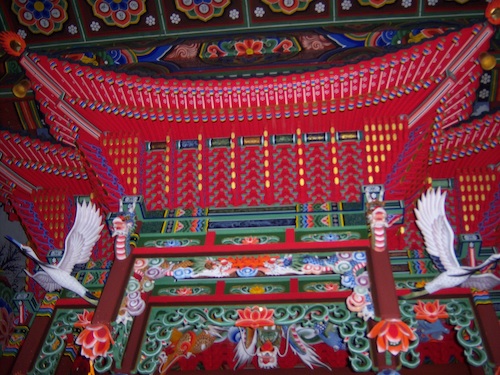
If two brane universes were to collide, they would wipe out any structures that might have coalesced during either of their histories. The tremendous energy harbored in their relative motion would yield a fiery rush of particles and radiation that would obliterate any organized structure that either brane universe contained. This cataclysm would be not only an end but a beginning, setting a stage for a cosmic rebirth. Indeed, a three-brane filled with a blistering plasma of particles and radiation would respond like an ordinary three-dimensional spatial expanse: it would expand. We might call it the big splat.
Buddhists are cremated in a monastic funeral called Da-bi. The platform, with wood, charcoal and a straw mat, is set up. After burning them, the bones of the cremated are crushed into powder, then either scattered around a temple or mountain, or kept in the charnel house. After cremation, the 40-day Guiding Ceremony takes place in the temple, its purpose being to yield a good rebirth in the next life. Choi-do-jae is another ceremony, intended for guiding ancestors to the Pure Land. Descendants make offerings and pray to the Buddha to purify their ancestors’ karma, so that they may be reborn in the Pure Land.

The essence of this cosmology involves worlds that repeatedly cycle through time, generating a new variety of parallel universe called the Cyclic Multiverse. If we are living on a brane in the Cyclic Multiverse, the other member universes are in our past and future. Steinhart and his co-workers estimated the time scale for a full cycle of the colliding cosmic tango — birth, evolution and death — and came up with about a trillion years. In this scenario, the universe as we know it would merely be the latest in a temporal series, which may have contained intelligent life and the culture that they created but have long ago been extinguished.
Su-ryuk-jae, a Guiding Ceremony for Earth and Water, is a special offering to the hungry ghosts. In the Yang Dynasty, King Mu dreamt that a monk called on him to hold a ceremony for the hungry ghosts of Earth and Water. The king adhered to the monk’s request. Though originally Chinese, Su-ryuk-jae is practiced nationwide in Korea. Ye-su-jae, a personal preparation ceremony, cultivates merits for the next life after death. This ceremony allows one to be reborn in a good realm by repenting bad karma, keeping the precepts and practicing charity. Koreans, accordingly, are tempted by Christianity.
Day 7
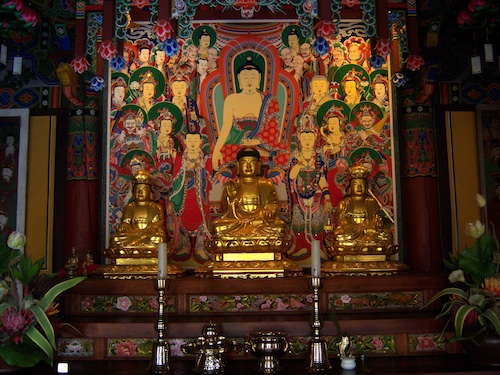
Through the temple stay program Korean temples are opened to foreigners, so that they may experience traditional Korean Buddhism. This program was initiated during the 2002 FIFA World Cup. The temple stay offers visitors the chance to engage in the daily life of a Korean temple for several days. The temple becomes active at 3 am, and various ceremonies and activities continue throughout the day until 9 pm. Every day several programs introduce the culture of Buddhism, such as Yebool (Buddhist ceremony service), Cham-seon (meditation), Da-do (tea ceremony) and Balwoo-gongyang (eating manners).
The new universe will rapidly expand and continue to transform the extra dimensions as it spreads. But since the new universe’s cosmological constant has decreased — its altitude in the landscape is lower than the original — the repulsive gravity it experiences is weaker, and so it will not expand as fast as the original universe. We thus have an expanding bubble universe, with the new form for the extra dimensions contained in even faster expanding bubbles, along with the original for the extra dimensions.
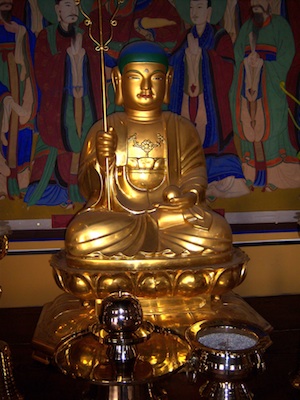
Prior to starting this program, all participants learn basic manners in the Buddhist temple and the Buddha Hall. One’s dress in the temple must be clean and conservative, and visitors should avoid revealing attire and bare feet as well as heavy makeup (male and female alike). Inside the temple they should be quiet and calm. Visitors should not speak loudly, run or sing. Smoking is not allowed and alcohol is strictly forbidden. Men and women should also avoid intimate physical contact. During the act of Yebool participants maintain a quiet and calm composure, in body and mind, for this harmonious Buddhist ceremony.
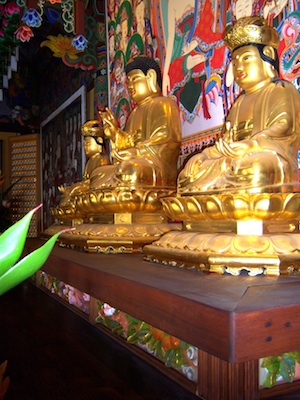
The process can repeat itself. At other locations inside the original universe as well as the new one, further tunneling events cause additional bubbles to open up, creating regions with yet different forms for the extra dimensions. The expanse of space will be riddled with bubbles inside of bubbles inside of bubbles — each undergoing inflationary expansion, each with a different form for the extra dimensions, and each with a smaller cosmological constant than the larger bubble universe within which it formed.
Balwoo-gongyang is a meal with traditional bowls. In Buddhism, gongyang means eating, and balwoo are bowls containing a moderate amount of rice and vegetables. The spirit of the Balwoo-gongyang is equality, cleanliness, thrift and togetherness. Equality means that everyone has the same amount of food; cleanliness means that the food is cooked in a clean environment; thrift means that there is no waste; and togetherness means that social unity and harmony are thereby enhanced. Balwoo-gongyang is performed three times a day. One sits in the lotus position and remains quiet, since talking is not allowed.
Day 8
Korean temples generally have a two-story tower, which visitors can see upon entering the gate. There are four major Buddhist instruments to announce the time for monks to practice their daily rites. The four instruments are the dharma drum, the wooden fish, the cloud-shaped gong, and the large brahma bell. The sound of each instrument has a function in saving beings of other realms. The dharma drum beats to save all beings living on earth, from humans to animals to ants. The sound of the beating drum is considered to echo the sound of Buddha’s teachings and so bodes well for all humankind.

But what about all the other features of our universe — the existence of three kinds of neutrinos, the particular mass of the electron, the strength of the weak nuclear force, and so on? While we can at least imagine calculating these numbers, no one has as yet managed to do so. You might wonder whether their values, too, are ripe for a multiverse-based explanation. Indeed, researchers surveying the string landscape have found that these numbers, like the cosmological constant, also vary from place to place.

The wooden fish is for saving all fish. Monks strike both sides of the fish’s hollow center with two sticks in order to produce sound. The origin of this instrument can be traced to an edifying story. A long time ago there was a monk who committed many unwholesome deeds. Eventually he died and was reborn as a fish with a tree on his back. One day when the monk’s old master was crossing the river, the fish came to him sadly. The master looked into its past life and held a memorial ceremony to save the fish. That night, the fish appeared in the master’s dream, appreciative of the master’s kindness.
And hence — at least in our current understanding of string theory — they are not uniquely determined. This leads to a perspective different from what dominated the early days of research on the subject. It suggests that trying to calculate the properties of the fundamental articles, like trying to explain the distance between the earth and the sun, may be misguided. Like planetary distances, some of — or all — the properties would vary from one universe to the next, assuming that our universe is in this landscape.
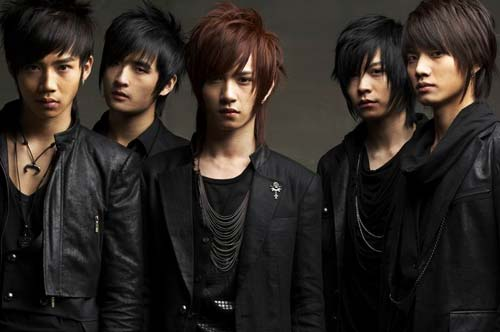
He asked his master to cut the tree from his back and make a fish-shaped instrument. The cloud-shaped gong, made of bronze, is for saving the beings that inhabit the sky. Some temples hang this gong in the dining room to announce meetings. The brahma bell is for saving the beings of hell. It is struck 28 times in the morning and 33 times in the evening. As it is struck all beings are released from suffering. A whale-shaped instrument is used to strike the bell. Long ago, many dragons lived in the sea. One, named Po, cried often and was afraid of whales. The bell’s sound is said to sound like Po’s cries
Day 9
The quantum revolution required that we give up the classical perspective, because new results established that it was demonstrably wrong. For the motion of big objects like the earth and the moon, or of everyday objects like rocks and balls, the classical laws do a fine job of prediction and description. But pass into the microworld of molecules, atoms and subatomic particles and the classical laws fail. In contradiction of the very heart of classical reasoning, if you run identical experiments on identical particles that have been set up identically, you will generally not get the identical results.
The mok-tak and juk-bi are also very important instruments in daily Korean temple life. The mok-tak is shaped like the wooden fish, but it is smaller and round. It is used in all Buddhist ceremonies, when the chanting of sutras is required. The juk-bi is made out of a single bamboo shoot that is cut down its center. A monk will slap the juk-bi against his palm to elicit sound. It is a useful instrument to signal the beginning and end of meditation. Another interesting small instrument is the set of wind chimes, found on the eaves of Buddhist halls and pagodas. When the wind rings the chimes, the monks awaken.

Quantum mechanics applies not just to electrons but to all particles, and it tells us not only about their positions but also about their velocities, their angular momenta, their energies, and how they behave in a wide range of situations, from the barrage of neutrinos now wafting through your body, to the frenzied atomic fusions taking place in the cores of distant stars. Across such a broad sweep, the probabilistic predictions of quantum mechanics match experimental data. Always. There has not been a single verifiable experiment or astrophysical observation whose results conflict with these predictions.
Many Buddhist symbols have an explanation in a story behind them. The explanation for the chimes’ role lies in the analogy that fish live without closing their eyes, even while they are asleep. Thus the monks and the practitioners, like the fish in the sea, practice continuously so as to cultivate themselves, even in their dreams. In Korean Buddhism there are many symbols to represent the Buddha’s teaching. The Buddhist cross is called man in Korean. Its original meaning in Sanskrit is “a good omen.” Since Buddha’s time it has been a symbol of good fortune, and it represents Buddha’s compassionate mind.
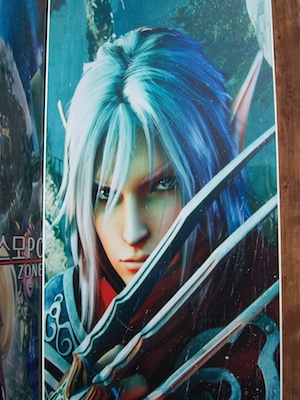
At the Relativistic Heavy Ion Collider (RHIC) in Brookhaven, New York, gold nuclei are slammed into each other at just shy of light speed. Because the nuclei contain many protons and neutrons, the collisions create a commotion of particles that can be more than 200,000 times as hot as the sun’s core. That is hot enough to melt the protons and neutrons into a fluid of quarks and the gluons that act between them. Physicists have exerted great effort to understand this fluidlike phase, called the quark gluon plasma, because it is likely that matter briefly assumed this form soon after the big bang.
In the Buddhist symbology a circle by itself and a circle with three dots (or circles again) inside it are also figures of special import often found in Buddhist designs and in the murals that appear in temples. The circle with circles inside it represents the mind. The circle too is a fundamental figure for the whole universe, without worldly distinctions (such as good or bad, like or dislike, high or low). As for the meaning of the three dots: the inside of each dot symbolizes one of the three jewels of Buddhism. The three jewels of course are: the Buddha, the Dharma (his teachings) and the Sangha (his disciples).
That familiar reality may be mirrored, or perhaps even produced, by phenomena taking place on a faraway, lower-dimensional surface ranks amongst the most unexpected development in all theoretical physics. But how confident should we be that the holographic principle is right? Do black holes really have nonzero entropy and temperature, and, if so, do the values conform to theoretical predictions? Is the information capacity of a region of space really determined by the amount of information that can be stored on a surface that surrounds it? It is possible that one of these intermediate steps is wrong.
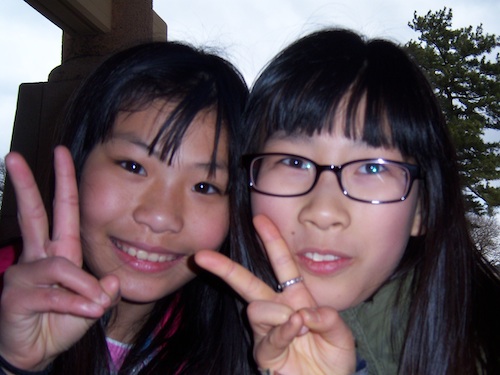
Sources of Quotations
Brian Greene, The Hidden Reality (New York: Penguin, 2011)
Pak, Youngsook and Roderick Whitfield, Buddhist Sculpture (Seoul: Yekyong, 2006)
Plus many sources for Korean Buddhism found over the Internet.
(Most quotations have been modified or combined with others.)